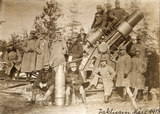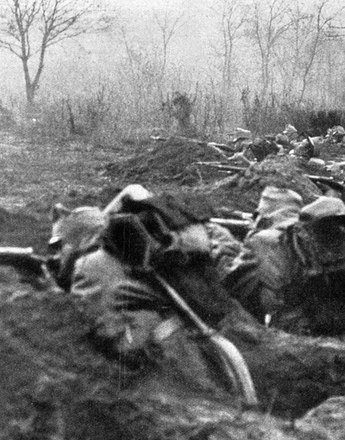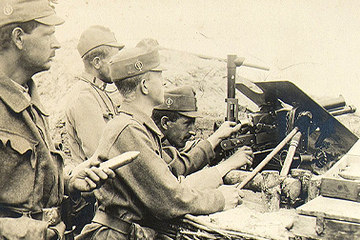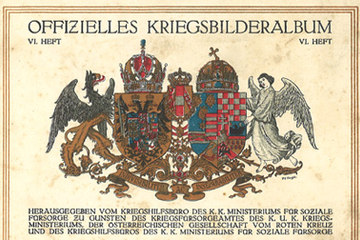World War photography between traditional pictorial conventions and the Modern
-

“Morning light, morning light, are you leading me to an early death?” Example of a suggestive photograph
Copyright: dform
-

Group photo with artillery, Leopold Wolf war photo album, 1915
Copyright: Sammlung Frauennachlässe, Institut für Geschichte der Universität Wien/Fotografie: Angelika Spangel
Partner: Sammlung Frauennachlässe, Institut für Geschichte der Universität Wien -

“The last farewells from the family to the entrained soldiers leaving for the theatre of war”, photo from das Interessante Blatt, issue of 6 August 1914
Copyright: ÖNB/ANNO
Partner: Austrian National Library
In the First World War, visual representation developed into its own dimension of the war. Photography and film became the leading media for representing the war and determined society's perception of it.
It was only in the course of the First World War that photography became the leading medium for war reporting. Previously, war illustrators and battle painters gave visual expression to the events of the war. As photography became a mass medium, a visual canon was created that suggested authenticity and objectivity. War photographs appeared in newspapers and magazines, were printed on postcards and presented to the public in exhibitions and on display panels.
However, the representational patterns of the photography of the industrialised war remained largely conventional and bound by the iconographic traditions of the 19th century. One characteristic element was the need to show the war from its heroic site. This applies in particular to the official pictorial reporting and the photos that were taken shortly after the start of the war. The recruits had themselves photographed in heroic poses in photo studios, and the images show confusingly similar portraits of the heroes-to-be, men in uniform standing in front of their parents' homes, ready to leave, posing alone in front of wide expanses or places of entertainment in which leave was being taken. Other illustrations show the soldiers as travellers and hikers, taking up tourist traditions or in the tradition of military genre painting and family photography.
Equally conventional are the pictures that recorded the optimism of the first days and weeks of the war. Their content repeats itself, showing streets full of soldiers marching to war, flanked by cheering masses, and speak of the heroism of victorious times. Official war photographers in particular continued the tradition of war painting – they produced dramatic pictures depicting the people, the dynasty and the war as a single entity. Private photographers took photos that departed from this pictorial canon, taking photographs beyond the established taboos and with different representational patterns.
At the same time, however, the war could not be pictured like preceding wars – it lacked spatial limits and did not abide by the demarcation lines of the battlefield. For this purpose, it was necessary to find new forms of documentation, and the new developments in photography provided previously unknown opportunities for doing so. The introduction of small roll film cameras and short exposure times made snapshots possible. Clouds of gunpowder and explosions, rapid movement and exciting battle scenes recorded on photographic paper showed dramatic moments of individual fates. At the same time, however, the photographic perspectives recalled the condensed motifs of modern battle paintings. In this respect, the iconographic tradition, expanded in its possibilities by technical developments, was all the more continued by world war photography.
Translation: David Wright
Holzer, Anton: „Üb Aug‘ und Hand fürs Vaterland!“ Österreichische Kriegsfotografie im Ersten Weltkrieg, in: Vocelka, Karl u.a. (Hrsg.): Geschichte in Bildern? Wiener Zeitschrift zur Geschichte der Neuzeit (2006), 2, 87-98
Hüppauf, Bernd: Fotografie im Ersten Weltkrieg, in: Spilker, Rolf/Ulrich, Bernd (Hrsg.): Der Tod als Maschinist. Der industrialisierte Krieg 1914–1918. Eine Ausstellung des Museums Industriekultur Osnabrücl im Rahmen des Jubiläums „350 Jahre Westfälischer Friede“ 17.Mai–23.August 1998, Osnabrück 1998, 108-123
Hüppauf, Bernd: Kriegsfotografie, in: Michalka, Wolfgang (Hrsg.): Der Erste Weltkrieg. Wirkung, Wahrnehmung, Analyse, München/Zürich 1994, 875-910
-
Chapters
- Public relations in the First World War: the state organisation for war reporting
- The WPH Photograph Office
- "Embedded photography": war photographers as part of military logistics
- Photography as a weapon: reconnaissance, surveying, documentation
- Who photographed the war? Snapshooters, amateurs, front tourists
- The canon of images of the First World War as reflected in the illustrated press
- The photographer as documentarian: the amateur's eye
- World War photography between traditional pictorial conventions and the Modern












